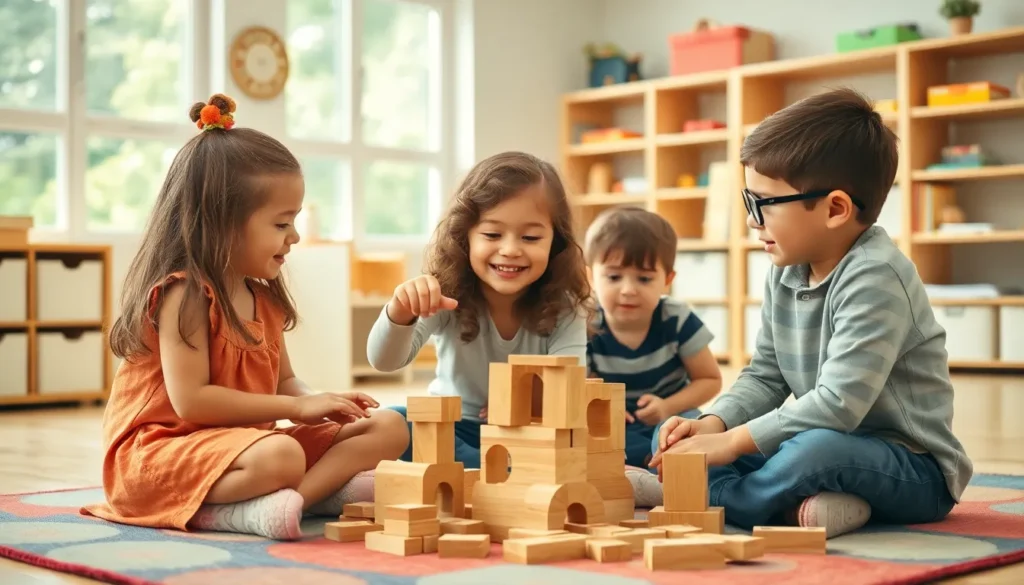Table of Contents
ToggleIn a world overflowing with flashy toys that break faster than a toddler’s attention span, Montessori toys stand out like a unicorn in a sea of rubber ducks. These gems are not just colorful distractions; they’re designed to spark creativity and enhance learning in a way that even the most reluctant little learners can’t resist. Imagine a toy that not only entertains but also teaches problem-solving skills and independence—sounds like a parenting win, right?
Montessori toys encourage exploration and imagination, making them the perfect allies in a child’s developmental journey. They’re crafted to grow with kids, transforming from simple playthings into tools for critical thinking. So why settle for toys that end up in the back of the closet when you can invest in something that fuels curiosity and fosters growth? Dive into the world of Montessori toys and discover how they can turn playtime into a powerful learning experience.
Overview of Montessori Toys
Montessori toys consist of educational materials designed to promote a child’s natural learning process. These toys encourage exploration and hands-on learning, aligning with the Montessori philosophy. A focus on open-ended play fosters creativity and imagination among children.
Parents prefer Montessori toys for their ability to adapt to various developmental stages. Many options help enhance fine motor skills, sensory experiences, and cognitive abilities. Quality materials, such as wood or natural fabrics, create a safe and engaging environment for children.
Examples of Montessori toys include shape sorters, stacking toys, and puzzles. Shape sorters assist in recognizing colors and shapes while developing hand-eye coordination. Stacking toys offer opportunities for problem-solving and spatial awareness. Puzzles challenge critical thinking as children learn to identify shapes and fit pieces together.
Montessori toys often feature simple designs that promote independent play. This simplicity allows children to focus on learning, free from excessive distractions. Diverse ranges of toys also cater to varying interests, ensuring every child finds something appealing.
Parents and educators appreciate that Montessori toys extend beyond mere entertainment. These tools provide valuable experiences that encourage curiosity and self-directed learning. Selecting Montessori toys contributes significantly to a child’s growth and development during early learning stages.
Benefits of Montessori Toys

Montessori toys provide numerous advantages for children’s learning and development. These benefits directly support autonomy, cognitive skills, and creativity.
Encouraging Independence
Montessori toys promote independence by allowing children to engage in self-directed play. Children decide how to interact with these toys, which builds confidence in their abilities. Options like stacking rings and shape sorters require kids to explore and problem-solve without constant adult intervention. Parents observe children discovering solutions independently, enhancing their autonomy. Age-appropriate challenges stimulate motivation, as children take pride in completing tasks. The innovative designs encourage hands-on experiences, fostering a sense of ownership in learning.
Fostering Cognitive Development
Cognitive development thrives through the use of Montessori toys. These toys stimulate critical thinking and problem-solving skills. Puzzles, for instance, introduce complex concepts such as spatial awareness and logical reasoning. Engaging with varied textures and colors enhances sensory perception, driving curiosity and exploration. The simplicity of these toys allows children to focus deeply on one activity, which aids concentration. Open-ended play encourages creative thinking, as children invent stories and scenarios while interacting with their toys. Through these learning experiences, children build important cognitive foundations that support future academic success.
Types of Montessori Toys
Montessori toys come in various types, each designed to enhance different aspects of a child’s development. Here are several key categories that are essential to understanding their benefits.
Manipulative Toys
Manipulative toys engage children in hands-on activities. These toys include items like building blocks and lacing beads, which promote fine motor skills. Children learn to grasp, pull, and position objects, facilitating dexterity. As kids experiment with these toys, they build problem-solving abilities. Additionally, stacking toys encourage spatial awareness, allowing children to explore balance and symmetry.
Sensory Toys
Sensory toys stimulate children’s senses through varying textures, sounds, and colors. Items like sensory bins filled with rice or sand provide tactile exploration. In this way, children enhance their sensory processing skills while playing. Toys that produce sounds engage auditory senses, encouraging kids to listen and react. Awareness of different materials fosters curiosity, igniting imaginative play.
Language and Literacy Toys
Language and literacy toys foster communication and reading skills from an early age. Picture cards and alphabet blocks help children recognize letters and words. Engaging with these toys promotes vocabulary development, increasing language comprehension. Storytelling kits encourage imaginative narratives, enhancing creativity and expression. Children using these toys become more confident communicators through play.
Selecting the Right Montessori Toys
Selecting the right Montessori toys involves careful consideration of age-appropriateness and safety to ensure a beneficial play experience.
Age-Appropriate Options
Choosing age-appropriate options enhances a child’s developmental experience. For infants, sensory toys encourage exploration through textures and sounds. Toddlers benefit from manipulative toys like stacking blocks that improve fine motor skills and problem-solving abilities. Preschoolers can engage with more complex puzzles to stimulate critical thinking and enhance spatial awareness. Each toy should align with the child’s developmental stage to maximize learning and engagement.
Safety and Quality Considerations
Safety and quality considerations are paramount when selecting Montessori toys. Opt for toys made from non-toxic materials that avoid small parts, reducing choking hazards. Look for sturdy construction to withstand active play. Certified safety standards such as ASTM or EN71 indicate reliable manufacturing processes. Regular inspections for wear and tear also help maintain toy safety. Prioritize quality as it ensures the toys remain beneficial throughout various stages of childhood development.
Choosing Montessori toys can significantly enhance a child’s developmental journey. These thoughtfully designed tools not only entertain but also nurture essential skills like problem-solving and creativity. By fostering independence and encouraging self-directed play, Montessori toys empower children to explore their interests at their own pace.
Parents can feel confident in their investment as these toys adapt to a child’s evolving needs. With a focus on quality and safety, Montessori toys ensure a productive and engaging play experience. Embracing these educational resources can lead to meaningful growth and joyful learning moments for children during their formative years.







